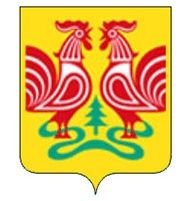Petushki

The town of Petushki is the administrative center of the Petushki district of the Vladimir region, one of the smallest towns – with a population of 13,620 people (2016). It is located on the left bank of the Klyazma River, 63 km south-west of Vladimir. Through Petushki passes the Moscow-Nizhny Novgorod railway and the M-7 Volga highway.
History
Petushki is a provincial town, which was a village half a century ago. It originated at Petushki station, opened in 1861. The station was named after the neighboring village of Petushki (today it is Old Petushki). This village was first mentioned in church census books of 1678. The inhabitants of Petushki had long been engaged in "dvornichestvo", that is, the maintenance of inns ("postoyaly dvor" – in Russian), which was determined by the location of the village – on the big road going from Moscow to Vladimir, and then to Nizhny Novgorod.
Since the 18th century, the Vladimir tract (the notorious Vladimirka) was used to send convicts to Siberia for hard labor. Arresters, who were shackled, walked "by stage" by small detachments-parties. After 15-25 versts (stage), the prisoners stopped to rest. The tragic story of the road inspired the artist I.I. Levitan to create the picture "Vladimirka", when he was on vacation in 1891 in these places (now in the village of Eliseikovo, Petushki district, the museum "The House of Landscape named after I.I. Levitan" is opened).
The construction of the railroad determined the relocation of a part of the inhabitants of the village of Petushki closer to it and the formation of a settlement with a wooden railway station. By 1869, when double-track train movement appeared, a large brick terminal (still preserved) and a locomotive depot had been built at the station. The station became operational, where steam locomotives were changed, their inspection and repairs were performed, and the work on shipment of wood and firewood was expanded. Together with the station, the worker’s settlement of Petushki also grew.
There are many interpretations of the name of the settlement – Petushki. The most peaceful of them are connected either with the traditional manufacture in these places of children's whistles in the form of cockerels, which were in great demand at the Nizhny Novgorod and the Makaryev fairs, or – with smoke holes in the shape of a cock spread here, which are still preserved on some houses. But there are also enough sinister interpretations: the robbers, who had long traded on the big road, warned of their appearance by the shout of a cock, when attacked the merchants passing by. And, supposedly, there was a custom, apparently for Drozhzhin and Efremov building a house. Whatever the version, but the cockerels – the symbol of the city –are now depicted on the official coat of arms of Petushki, approved in 2009.
The construction of the railway attracted entrepreneurs, and in the 1910s industrial production began in Petushki. The Krasheninnikov brothers built a weaving factory for 50 manual machines (later – the "Labor collective" factory). The entrepreneur Dyukov opened a the artel producing velvet. Turning and carpenter's factory was founded by Drozhzhin and Efremov which later became a bobbin-reel. Genushkevich’s plant began the production of silica brick.
The village Petushki received the status of the settlement in 1910, when the magnificent temple – the Holy Assumption Church – was consecrated here, built up at the expense of the local factory owner Kuznetsov. The church still exists today.
The settlement at the station developed, attracting the surrounding population, and grew up with new streets. In 1928, it received the status of a worker’s settlement of urban type and was renamed to the New Petushki. In 1929, it became the center of the newly formed Petushki district. Petushki became the town only in 1965.
Economy
Today Petushki, although a small town, but still an industrial center with a number of enterprises, including such a unique and promising, as the plant of steel piston rings. Nevertheless, the main production spectrum is textile and food industries.
Sights
Tourist interest can be represented by one of the eight surviving hyperboloid towers in Russia, the design of the engineer and scientist V.G. Shukhov (the most famous Shukhov’s tower is on Shabolovka in Moscow). He was the first in the world to create such a steel mesh construction for the All-Russian Exhibition in Nizhny Novgorod in 1896. However, the state of the Petushki hyperboloid water tower is rather deplorable today.
In the city There is the only in Russia art Museum of a Cock, founded in 1997 by artist and journalist N. Kornilov. The museum has a large collection of paintings, dishes, embroideries, installations from various materials on the "cock" theme, which is of great interest both in children and adults. The museum is located in the district House of Culture.
Famous people
The town entered the Russian cultural context after the appearance of V. Erofeev's poem "Moscow-Petushki" (1970, officially published in the USSR only in 1988). Venichka Erofeev himself lived in Petushki for no more than two years. For the first time he came here in 1959 and got a job as a loader for a cement warehouse. Contrary to popular belief, there is no monument to Venedikt Erofeev in Petushki. In 2000, the monument to Erofeev was installed in Moscow, in the square of Borba (metro Mendeleyevskaya). But a small museum of the writer was created in Petushki (Sovetskaya Square, 3), the exposition of which contains personal belongings of the writer, literally bit by bit collected in different corners of Russia.
 Tourism portal of the
Tourism portal of the